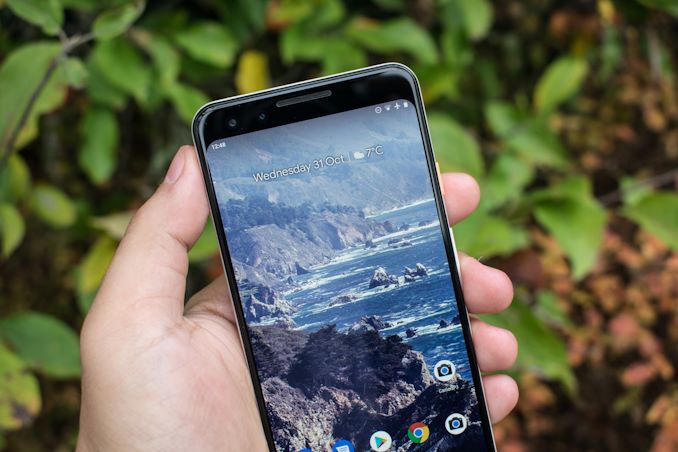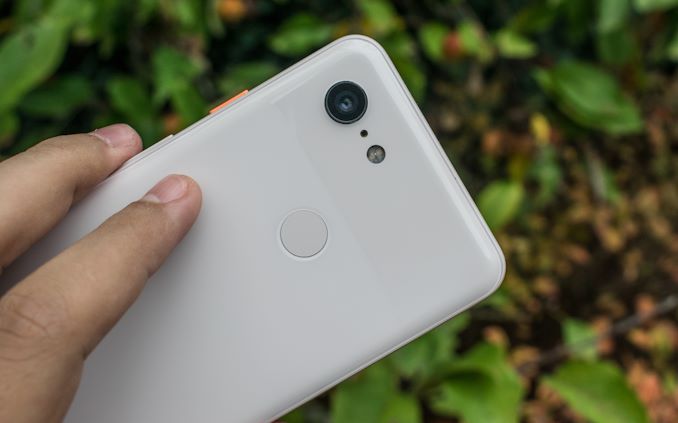The Google Pixel 3 Review: The Ultimate Camera Test
by Andrei Frumusanu on November 2, 2018 11:00 AM EST- Posted in
- Smartphones
- camera
- Mobile
- Pixel
- Snapdragon 845
- Pixel 3
Conclusion & End Remarks
The Pixel 3 is very much a Google phone, in the every sense of the meaning.
Design-wise we can only talk about the small Pixel 3 as that’s what we got sampled. The front of the phone got a much needed face-lift compared to the Pixel 2, and it just looks a lot more like a modern phone due to its increased screen-to-body ratio as well as reduced bezels. The new glass back design is also a positive for me – it does bring wireless charging, and the matte chemically etched finish on the glass avoids the usual negatives about glass phones such as smudges and fingerprint residue.
I’m not too convinced about the build quality of the glass back – it suffers from an air gap and flexes in, which causes it to touch and separate from the wireless coil and battery when pressing the back in. This also seems to be source of some sound distortion when playing back at maximum volume.
Back to the front of the phone, the new OLED display is good. It’s able to represent accurate colours both in sRGB and DCI-P3, albeit the latter’s software support in applications is still essentially non-existent for the vast majority of users. Google has now swapped panel suppliers between the big Pixel 3 XL and smaller Pixel 3, with LG now sourcing the panel for the small Pixel 3. The panel is definitely an improvement over the Pixel 2 XL panel, however the issue of black clipping at low brightness levels is still present (albeit much improved). Here Samsung’s panels are just better in this regard. Brightness of the Pixel 3 display is also standard – it goes up to 400 nits, and no more, so it doesn’t perform quite as well as some other super bright models from the competition.
On the hardware side of things, the Pixel 3’s now come with the Snapdragon 845 SoCs from Qualcomm. Currently the silicon, as well as Google using the most up-to-date version of Qualcomm’s scheduler, make this the snappiest and fastest device on the market. A big contribution to this is also Google’s cutting edge software stack for storage and filesystem.
In terms of gaming performance, the Pixel 3 falls in at the low end of Snapdragon 845 devices. Here the thermal limits limit sustained performance, and the phone isn’t allowed to use as much power as say, the OnePlus 6 does.
Battery life of the Pixel 3 is average. Although there’s a slight increase in battery capacity which should make it last longer, the new phone also has a bigger screen, and the performance of the SoC is much greater, which both draw more power. There’s a small decrease in battery life compared to the Pixel 2, but overall, it still ends up within reasonable figures.
The camera was a big topic for the Pixel 3, and it is a make-or-break feature. If you haven't read our 18-phone shootout on the previous pages, it is highly recommended.
The big camera feature of the Pixel 3 is Night Sight. Here Google is really able to showcase its software strengths, and brings to market a night mode that one-up’s Huawei’s feature, which lead the way in terms of computational photography this year. Google’s implementation is better, allowing for significantly better light capture in low-light, as well as retaining an astounding amount of detail.
(It should be noted that I used a modified camera app to enable Night Sight for this review, as it is not currently enabled in retail devices. This whole conclusion might have come out extremely different, as Google’s regular shooting modes in low light still largely lags behind the competition from Samsung and Apple.)
Google’s advertised Super Res Zoom, to get better resolution in zoomed modes, certainly works, but only so far. It does bring an improvement over traditional digital crop zooming, however the benefits are relatively limited to an about 50% increase in spatial resolution, or about an equivalent zoom factor of 1.5x. Here software can’t compensate or compete with the dedicated telephoto modules of other phones.
On the camera hardware side, Google has made minor updates - the sensor and optics of the Pixel 3 are nearly identical to the Pixel 2, and in daylight pictures it is indeed very hard to find much difference in picture quality between the two phones. There is a slight difference in colour temperature, but otherwise the image processing as well as details are pretty much the same, which includes some notable weaknesses sometimes, such as bad retention of details in shadows.
Audio wise, the Pixel 3 greatly improves the speakers, notably improving the bass and low-mid-ranges, giving a lot more depth to the audio. Unfortunately the 3.5mm headphone jack is gone for good – and if you’re looking to get good audio out of the phone, you’ll also have to look for a different pair of headphones. The included USB-C pair of headphones in the box sound terrible.
The Pixel 3 comes with the latest version of Android. It should be said that the new gesture navigation on the Pixel 3 seems largely pointless. For me, it brings no benefit over the 3-button navigation scheme, and it’s actually a worse way to use the phone as for me it’s just more cumbersome. Many had hoped Google would improve on this following the initial release of the Android P release candidate, but that unfortunately didn’t happen.
Should I Buy It?
Overall, is the Pixel 3 a worthwhile phone to purchase? The problem here is I think unless you’re very entrenched in Google’s software ecosystem and you make good use of many of Google US-exclusive features on the Pixel, then you might want to consider some other alternatives or just wait out the next generation from the big vendors. Google’s release schedule, which is out of sync with SoC vendors, means that the Pixel is again a half-way point between generations. On top of that, Google is demanding the full price of a new flagship, while lacking some of the features or build quality of said flagships.
Here really the only exciting part about the Pixel 3 is its excellent performance as well as its new Night Sight camera mode. If that’s enough for a user to justify the price, then the Pixel 3 will surely enable a good user experience.












135 Comments
View All Comments
saleri6251 - Friday, November 2, 2018 - link
Hello Andrei,Thanks for the review as always. Just curious do you have any thoughts on the Titan M Security Chip?
Andrei Frumusanu - Friday, November 2, 2018 - link
I didn't have much time to get into it, we covered Google Hot Chips presentation: https://www.anandtech.com/show/13248/hot-chips-201...cha0z_ - Monday, November 5, 2018 - link
Hey, as we speak about chips - can you include/test the note 9 exynos? It's bigger body compared to the s9 and also has a lot better coolling. We all read your articles about the exynos 9810 + a lot about in @ xda, but it will be really nice to see where the more popular note 9 exynos stands with it's bigger coolling and body compared to the competition and s9/s9+.If you have the time and the desire, otherwise it's also cool - you do a lot of great reviews about phones/mobile SOCs. Keep it up and cheers!
cha0z_ - Monday, November 5, 2018 - link
No edit here: I am aiming primary at the sustained performance of the system/GPU tests. I am sure you already guessed it, but for the other members of the community.jordanclock - Friday, November 2, 2018 - link
As a P3XL owner, I can say this review completely matches my experiences.Also, that camera comparison is insane and Andrei is a mad-man for taking that many pictures AND THEN REVIEWING THEM ALL.
Andrei Frumusanu - Friday, November 2, 2018 - link
Thanks! The camera was a lot of work.This should also serve as a good comparison between all important phones over the last year or two. It's something I hope I won't have to do again till the S10.
jordanclock - Friday, November 2, 2018 - link
That last night shot is pretty similar to a comparison I showed my friends when they thought that it was just a gimmick.Have you also found that using the night shot for every shot seems to be a good default? I found that in general the night shot results are "good enough" compared to HDR+, but obviously has the benefit of better low-light results.
Andrei Frumusanu - Friday, November 2, 2018 - link
I've posted night mode pictures in daylight scenes as well, just to answer this question.There's no obvious difference and you can stay in night mode all the time, the only negative is that it'll be slower in terms of capture.
melgross - Sunday, November 4, 2018 - link
I’ve read that night mode is done after capture, not during, as Google, and other manufactures do their auto modes. So likely that’s why it’s slower.s.yu - Sunday, November 11, 2018 - link
Thank you for again the best set of samples on the net!This night mode just doesn't cease to amaze me, it preserves DR and enough(I'd say over 80%) resolution while accurately suppressing noise that it surpasses auto often enough even in daytime!
This is two notches above Huawei's night mode implementation, while Pixel's auto was better in the first place.